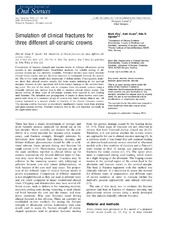Simulation of clinical fractures for three different all-ceramic crowns
Peer reviewed, Journal article
Published version
Permanent lenke
https://hdl.handle.net/1956/8904Utgivelsesdato
2014-04-04Metadata
Vis full innførselSamlinger
Originalversjon
https://doi.org/10.1111/eos.12128Sammendrag
Comparison of fracture strength and fracture modes of different all-ceramic crown systems is not straightforward. Established methods for reliable testing of all-ceramic crowns are not currently available. Published in-vitro tests rarely simulate clinical failure modes and are therefore unsuited to distinguish between the materials. The in-vivo trials usually lack assessment of failure modes. Fractographic analyses show that clinical crowns usually fail from cracks initiating in the cervical margins, whereas in-vitro specimens fail from contact damage at the occlusal loading point. The aim of this study was to compare three all-ceramic systems using a clinically relevant test method that is able to simulate clinical failure modes. Ten incisor crowns of three types of all-ceramic systems were exposed to soft loading until fracture. The initiation and propagation of cracks in these crowns were compared with those of a reference group of crowns that failed during clinical use. All crowns fractured in a manner similar to fracture of the clinical reference crowns. The zirconia crowns fractured at statistically significantly higher loads than alumina and glass-ceramic crowns. Fracture initiation was in the core material, cervically in the approximal areas.

